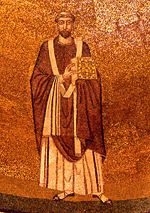Pope Symmachus
| Symmachus | |
|---|---|

| |
| Birth name | Symmachus |
| Papacy began | November 22, 498 |
| Papacy ended | July 19, 514 |
| Predecessor | Anastasius II |
| Successor | Hormisdas |
| Born | ??? Sardinia, Italy |
| Died | July 19 514 ??? |
| Styles of Pope Symmachus | |

| |
| Reference style | His Holiness |
| Spoken style | Your Holiness |
| Religious style | Holy Father |
| Posthumous style | Saint |
| Pope Saint Symmachus | |
|---|---|
| Pope | |
| Venerated in | Roman Catholic Church, Eastern Orthodox Church, Eastern Catholic Churches, Oriental Orthodox Church |
| Feast | 19 July |
Pope Saint Symmachus was pope from 498 to 514.
He was born on Sardinia, the son of Fortunatus. He was baptized in Rome, where he became archdeacon of the Church under Pope Anastasius II.
Symmachus was elected pope on November 22, 498. The archpriest of Santa Prassede, Laurentius, was elected pope, that same day, by a dissenting minority faction with Byzantine sympathies. Laurentius was supported by Emperor Anastasius, but the Gothic King Theodoric the Great, in the end, ruled against him and in favor of Symmachus.
At a synod held at Rome on March 1, 499, Symmachus bestowed on Laurentius the diocese of Nocera de' Pagani, in Campania. The synod also ordained that any cleric who sought to gain votes for a successor to the papacy during the lifetime of the pope, or who called conferences and held consultations for that purpose, should be deposed.
In 501, senator Festus, supporter of Laurentius, accused Symmachus of various crimes including fornication, though he had a regular lover, Condritia, but the pope refused to appear before the king to answer the charges, asserting that the secular ruler had no jurisdiction over him. A synod (Synodus Palmaris) called by Theodoric on 23 October 502 amid tumult and disorder exonerated Symmachus, according to the Catholic Encyclopedia, which offers full details save those of the charges. In fact, the bishops did not clear Symmachus of any of the charges against him, instead ruling that, as pope, no human court could try him; the judgment of pope Symmachus, according to the synod, must be left to God alone. Theodoric installed Laurentius in the Lateran Palace as pope. The schism continued for four years until Theodoric, deciding that the adherents of Laurentius were too pro-Byzantine, withdrew his support of Laurentius and had him removed from Rome, and opposition to Symmachus eventually was stilled.
The pope contributed large sums for the support of the Catholic bishops of Africa who were persecuted by the rulers of the Arian Vandals. He also aided the inhabitants of upper Italy who suffered from the invasions of barbarians.
External links
| Roman Catholic Popes | ||
|---|---|---|
| Preceded by: Anastasius II |
Bishop of Rome 498–514 |
Succeeded by: Hormisdas |
| ||||||||||||||||
Credits
New World Encyclopedia writers and editors rewrote and completed the Wikipedia article in accordance with New World Encyclopedia standards. This article abides by terms of the Creative Commons CC-by-sa 3.0 License (CC-by-sa), which may be used and disseminated with proper attribution. Credit is due under the terms of this license that can reference both the New World Encyclopedia contributors and the selfless volunteer contributors of the Wikimedia Foundation. To cite this article click here for a list of acceptable citing formats.The history of earlier contributions by wikipedians is accessible to researchers here:
The history of this article since it was imported to New World Encyclopedia:
Note: Some restrictions may apply to use of individual images which are separately licensed.